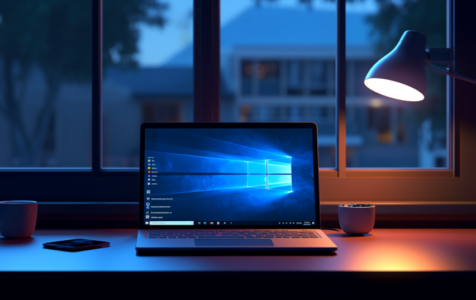- The "Getting Windows Ready. Do not turn off your computer" message is a common issue among Windows 10 and 11 users.
- Prolonged display can result from corrupted update files, malware, or software conflicts.
- Before intervening, allow up to 3 hours for updates to complete.
- Solutions range from power resets and system repairs to system restore and even Windows reinstallation.
- Regularly backing up data and maintaining a stable internet connection can mitigate such problems.
The message “Getting Windows Ready. Don’t turn off your computer” is common among Windows 10 and 11 users. This article outlines potential fixes when the message remains on screen longer than expected. The article outlines methods including a power reset, system restore, and more.
Common Causes
The prolonged display of this message can arise due to:
- Corrupted Update Files: These might be incomplete or not compatible with your version of Windows.
- Malware: Harmful software can obstruct the update process.
- Software Conflicts: Recently installed programs or those running in the background can sometimes clash with updates. Learn more about managing these conflicts in our guide on software issues.
Solutions
Wait
- Updates can be time-consuming; allow up to 3 hours if the message persists before taking further action. For a better understanding of Windows update processes, see Windows update errors. If there’s no change, proceed with the following steps.
Power Reset
- Turn off the PC, detach peripherals and power cables.
- For laptops with removable batteries, take out the battery.
- Hold the power button for 30 seconds.
- Reconnect power (and battery if removed) and restart.
Startup Repair
- Use Windows Recovery Environment from the installation disc.
- Navigate to “Advanced options” > “Startup Repair”.
System File Checker Tool
- Boot using installation media and opt for “Repair your computer”.
- Navigate to “Troubleshoot” > “Advanced options” > “Command Prompt”.
- Enter: sfc /scannow. Restart once done.
System Restore or Image Recovery
- Use the installation media, then choose “Repair your computer”.
- Go to “Troubleshoot” > “Advanced options”.
- Select either “System Restore” or “System Image Recovery”.
Remove Problematic Updates in Safe Mode:
- Access “Advanced options”, choose “Startup Settings”, and press F4 for Safe Mode.
- Within Safe Mode, go to “Control Panel” > “Programs and Features” and uninstall recent updates.
Reinstall Windows
- If other methods fail, you might need a clean Windows installation. Remember to back up your data before proceeding.
Software Check
- Some software can cause update interruptions. Consider uninstalling recently added applications in Safe Mode.
Additional Tips
- Data Backups: Regularly back up both your data and operating system.
- Stable Internet: Ensure you have a stable internet connection, particularly during updates. A wired connection offers more reliability for extensive updates.
Conclusion
Handling persistent “Getting Windows Ready” messages requires a blend of patience and proactive troubleshooting. While often a routine part of the update process, it’s essential to recognize when intervention is needed. By following the provided methods, Windows 10 and 11 users can address the issue efficiently and reduce potential system disruptions. Remember, regular backups and staying informed about updates can help prevent similar challenges in the future.
Expert Tip: For smoother PC performance, consider using a PC optimization tool. It handles junk files, incorrect settings, and harmful apps. Make sure it's right for your system, and always check the EULA and Privacy Policy.
Special offer. About Outbyte, uninstall instructions, EULA, Privacy Policy.
FAQ
Q: What does the “Getting Windows Ready” message indicate?
A: It indicates that Windows is undergoing an update or configuration process. It’s commonly seen during the Windows update process on versions 10 and 11.
Q: Why might this message display for an extended time?
A: Prolonged display can result from corrupted update files, malware infections, and conflicts with recently installed software.
Q: How long should I wait before intervening with the “Getting Windows Ready” message?
A: It’s recommended to wait up to 3 hours before taking any further action.
Q: How can I address the prolonged “Getting Windows Ready” message?
A: Solutions include performing a power reset, conducting a startup repair, using the system file checker tool, opting for system restore or image recovery, removing problematic updates in Safe Mode, reinstalling Windows, or checking for problematic software.
Q: Is there any preventive advice for the “Getting Windows Ready” message?
A: Regularly back up your data, ensure a stable internet connection during updates, and stay updated about any Windows updates or patches.
Q: What if none of the solutions provided in the article work?
A: Reinstalling Windows might be the final solution. Ensure to back up all your important data before proceeding with this step.
